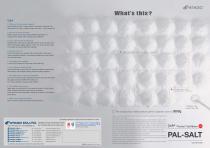
Catalog excerpts

What’s this? Q&A 1. What can this instrument measure? Various types of food – soups, sauces, condiments, dressings, fish, deli meats, brine, dairy, crackers, chips, and more – can be measured. 2. How do I measure my food? Different types of food may require different preparation for measurement. Please refer to “Measurement Method.” 3. Can I use tap water for dilutions? Distilled water is the best, but tap water may be used. Tap water may affect the readings slightly (approx. 0.01%). Do not use mineral water or ion water as they will affect the readings. 4. How do I clean it? The entire body can be washed under running water. Use soap to remove persistent residues. Clean greasy residues with ethyl alcohol and rinse with water. 5. The readings are unstable. Try stirring the sample on the sensor while measuring. 6. Can it measure cold / hot food? Leave the sample on the sensor for 30 seconds before measurement. Alternatively, take multiple readings until the readings stabilize. 7. How often does it need to be calibrated? Zero-set the instrument at the beginning of each day. Clean the sensor thoroughly and press ZERO with nothing on it. For official calibration, please contact ATAGO. 8. The readings seem wrong. Apply water or ethyl alcohol on the sensor and wipe it off with tissue paper. Repeat the process a few times if using water. If this does not solve the problem, reference set with a 2.5% standard salt solution. 9. What is the storage instruction? Store in the box that the instrument originally came in. 1 Tablespoon = 15g One pile of salt = 100g The average yearly intake of sodium / salt for a Japanese citizen is All ATAGO saltmeters are designed and manufactured in Japan. Headquarters: The Front Tower Shiba Koen, 23rd Floor 2-6-3 Shiba-koen, Minato-ku, Tokyo 105-0011, Japan http://www.atago.net/ overseas@atago.net ATAGO products comply with HACCP,GMP, and GLP system standards. * Specifications and appearance are subject to change without notice. Japan, a country renowned for its longevity (average life expectancy of 84 years old) consume this much salt. Around the world, most families have special recipes for a favorite dish. In Japan, every family has their own miso soup recipe. Individual preference in strength of miso soup’ s flavor can make a significant difference in salt consumption. A lightly seasoned miso soup can contain around 0.7g of salt in 100g of soup whereas a heavily seasoned miso soup may contain 1.2g of salt in 100g of soup. This difference in salt, when miso soup is consumed daily, adds an additional 274 grams (approx. 18 tablespoons) per year. Salt is a vital ingredient that brings out the flavor of food. Excessive salt consumption, however, may pose various health risks such as hypertension. A flavorful, savory miso soup can be made by balancing the amount of dashi (a Japanese soup stock) and the amount of miso. The proper balance reduces the need to add more miso thus reducing salt in the final dish. Whether for your family, guests, or customers, promoting a healthy low-sodium lifestyle is simply a few drops away with the PAL-SALT. “Pocket” Salt Meter
Open the catalog to page 1
“I have never used a salt meter.” “I have used / am currently using a salt meter.” A wide variety and price range of Users of conventional salt meters are salt meters are available online. often concerned with the durability of the ATAGO is your dietary salt reduction partner. instruments as well as the repeatability and Learn how the PAL-SALT is unlike any other salt meters on the market. ATAGO’s PAL-SALT was developed to satisfy the 0.00 to 10.0% (g/100g) of salt concentration 5.0 to 100°C 0.01% for salt concentration of 0.00 to 2.99% Resolution 0.1% for salt concentration of 3.0 to 10.0%...
Open the catalog to page 2All ATAGO catalogs and technical brochures
-
ap-300
2 Pages
-
CM-800
1 Pages
-
wine
2 Pages
-
Abbe refractomters
4 Pages
-
Repo
2 Pages
-
Visco
4 Pages
-
CLINICAL REFRACTOMETERS
2 Pages
-
MASTER series
2 Pages
-
Sac-i589/882
2 Pages
-
Digital EC Meter DEC-2
1 Pages
-
Hand-Held Refractometer N-8α
1 Pages
-
"PEN" Refractometer
2 Pages
-
"Pocket" Refractometer PAL-α
1 Pages
-
DEC-2
1 Pages
-
QR-Brix
2 Pages
-
PAN-1
2 Pages
-
DD-7
2 Pages
-
"Pocket" Refractometer PAL
2 Pages
-
Pen Pro Series
2 Pages
-
Hand-Held Refractometer N-8
1 Pages
-
Hand-Held Refractometer
8 Pages
Archived catalogs
-
ABBE REFRACTOMETERS
8 Pages
-
Atago - Polarimeter Polax-2L
2 Pages
-
PAL Special Scale
1 Pages
























































